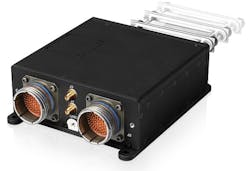Navy taps General Micro Systems to provide rugged embedded computing for airborne electronic warfare
POINT MUGU, Calif., 31 Oct. 2014. U.S. Navy avionics experts needed rugged general-purpose processors for a rapidly deployable electronic warfare (EW) system for U.S. Marine Corps fixed-wing aircraft and helicopters. They found their solution from General Micro Systems Inc. (GMS) in Rancho Cucamonga, Calif.
Officials of the Naval Air Warfare Center Weapons Division at Point Mugu, Calif., have awarded a $3.6 million contract to GMS to provide the company's S902R Golden-Eye III and S905R Raider III rugged processor and data-storage systems.
The GMS Golden-Eye and Raider embedded computing equipment are for the AN/ALQ-231(V) Intrepid Tiger II reprogrammable communications jammer for Marine Corps fixed-wing aircraft and helicopters. GMS will provide 105 Golden-Eye and 145 Raider systems for the Intrepid Tiger II program.
Intrepid Tiger II provides airborne electronic warfare and electronic attack communications jamming capability for Marine Corps fixed-wing aircraft and helicopters, as well as for unmanned aerial vehicles (UAVs), ground-based systems, and laboratories.
Navy officials have designated the AN/ALQ-231(V) Intrepid Tiger II as a rapid deployment capability to provide rapidly developed critical airborne electronic attack capability to ground forces, Navy officials say.
GMS is the original source of the system's rugged general-purpose processors, and is the only company that can provide processors and components without a substantial duplication of cost to the government, Navy officials say.
Related: Electronic warfare to be part of all military operations
The GMS Golden-Eye III is designed to provide rugged embedded computing for defense and UAV applications, as well as industrial and commercial applications, GMS officials say. It is widely deployed in Army vehicles, robots, and UAVs, and works with the Windows 7, Linux, and VxWorks operating systems.
The S902R Golden-Eye III small lightweight computer is conduction cooled and sealed, and operates in temperatures from -40 to 85 degrees Celsius without throttling, GMS officials say. The computer is based on the Intel i7 Core processor with as many as four physical CPU cores, as much as 16 gigabytes of SDRAM.
The S902R supports as many as five Gigabit Ethernet channels with TCP/IP offloading engine, six USB 2.0 ports, as many as four removable 2.5-inch solid-state drives, eight buffered digital I/O lines, dual video, four COM ports with RS232/422/485 options, and an audio headset jack with a one-watt audio amplifier to drive an 8-ohm speaker.
The Golden-Eye computer measures 5.38 by 6.88 by 2.13 inches, weighs 3.25 pounds, and consumes as little as 25 Watts of power.
The GMS S905R Raider III also is a rugged computer for defense and UAV applications that is designed for applications where a rugged computer is needed to provide the best possible performance per dollar per Watt, GMS officials say.
The Raider III supports the Intel i7 Core processor,and runs on the CANbus and MIL-STD-1553 databuses. Like its Golden-Eye cousin, it operates in temperatures from -40 to 85 C.
It is a fanless system that can be mounted directly to a metal surface or be used as a stand-alone system. It measures 5.5 by 5.5 by 1.24 inches, weighs 1.9 pounds, and runs on as little as 25 Watts of power.
For more information contact General Micro Systems online at www.gms4sbc.com, or the Naval Air Warfare Center Weapons Division at Point Mugu at www.navair.navy.mil.


